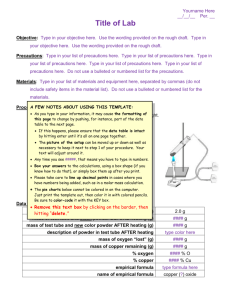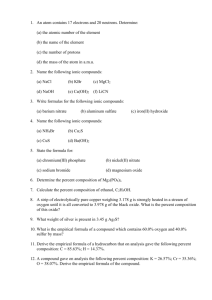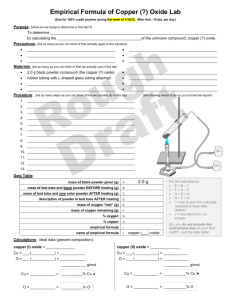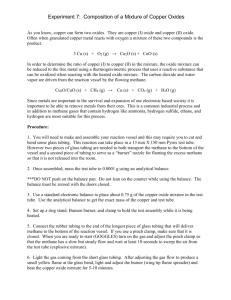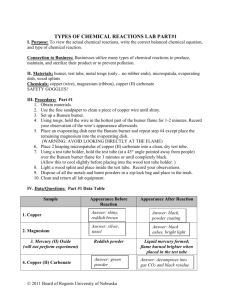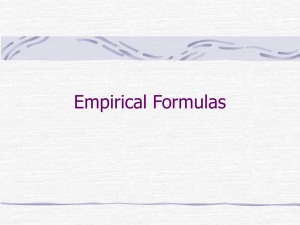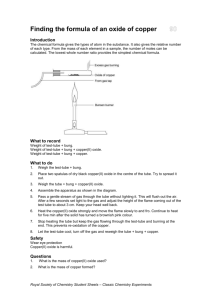Elemental Mass Percent and Empirical Formula from
advertisement
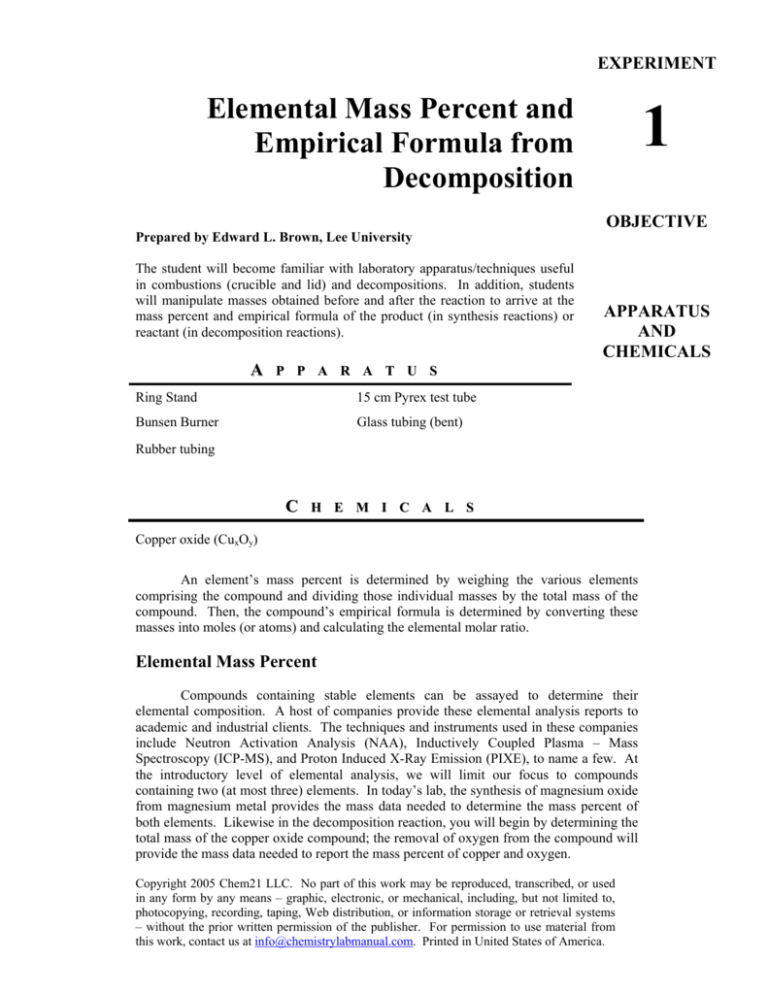
EXPERIMENT Elemental Mass Percent and Empirical Formula from Decomposition 1 OBJECTIVE Prepared by Edward L. Brown, Lee University The student will become familiar with laboratory apparatus/techniques useful in combustions (crucible and lid) and decompositions. In addition, students will manipulate masses obtained before and after the reaction to arrive at the mass percent and empirical formula of the product (in synthesis reactions) or reactant (in decomposition reactions). A APPARATUS AND CHEMICALS P P A R A T U S Ring Stand 15 cm Pyrex test tube Bunsen Burner Glass tubing (bent) Rubber tubing C H E M I C A L S Copper oxide (CuxOy) An element’s mass percent is determined by weighing the various elements comprising the compound and dividing those individual masses by the total mass of the compound. Then, the compound’s empirical formula is determined by converting these masses into moles (or atoms) and calculating the elemental molar ratio. Elemental Mass Percent Compounds containing stable elements can be assayed to determine their elemental composition. A host of companies provide these elemental analysis reports to academic and industrial clients. The techniques and instruments used in these companies include Neutron Activation Analysis (NAA), Inductively Coupled Plasma – Mass Spectroscopy (ICP-MS), and Proton Induced X-Ray Emission (PIXE), to name a few. At the introductory level of elemental analysis, we will limit our focus to compounds containing two (at most three) elements. In today’s lab, the synthesis of magnesium oxide from magnesium metal provides the mass data needed to determine the mass percent of both elements. Likewise in the decomposition reaction, you will begin by determining the total mass of the copper oxide compound; the removal of oxygen from the compound will provide the mass data needed to report the mass percent of copper and oxygen. Copyright 2005 Chem21 LLC. No part of this work may be reproduced, transcribed, or used in any form by any means – graphic, electronic, or mechanical, including, but not limited to, photocopying, recording, taping, Web distribution, or information storage or retrieval systems – without the prior written permission of the publisher. For permission to use material from this work, contact us at info@chemistrylabmanual.com. Printed in United States of America. Elemental Mass Percent and Empirical Formula Empirical Formulas The empirical formula of a compound is the simplest whole number ratio of its elements. This ratio can be either an atomic ratio or a molar ratio. The experimental determination of a compound’s empirical formula occurs in three steps: Step 1: Step 2: Step 3: Step 4: Determine the mass of each element present Convert the individual elemental masses into the number of moles of each element. Express the molar ratio of the two elements by dividing the number of moles of each element by the smaller of the two numbers. This will assign “1 mole” to the element with the smallest number of moles and the other element will be assigned a number greater than or equal to “1 mole”. This sequence of steps can be summarized using a table similar to Table 1.1. Each element is assigned a column, so that we are not limited by the ChemConneXions Map to just Elements A and B, but can determine the Empirical Formula for compounds containing multiple elements – our table will have multiple columns. Sample Problem 1.1: The electrolysis (decomposition) of water produced 23.2 mL of Hydrogen gas (density = 0.08988 g/L) and 12 mL of Oxygen gas (density = 1.429 g/L). What is the empirical formula of water? Step 1: Mass of the Elements 0.002085 g H 0.01715 g O Step 2: Moles of the Elements 2.085E-3 g ÷ 1.0079 g/mol 1.715E-2g ÷ 16 g/mol 2.0686E-3 mol H 1.072E-3 mol O Step 3: Divide by smallest moles Step 4: Write the empirical formula 1.93 mol H 1.00 mol O H2O1 or simply H2O Percent Composition from Empirical Formulas The percent composition of a compound is easily calculated if its empirical formula is known. An empirical formula gives us two essential facts about a compound’s elemental composition: the identity of the elements and their relative ratios. For example, water (H2O) is composed of 2 atoms of hydrogen and 1 atom of oxygen. This information, coupled with information displayed in the Periodic Table, allows the determination of the percent hydrogen and oxygen in water. Experiment 1 1-2 Elemental Mass Percent and Empirical Formula Sample Problem 1.2: Determine the percent hydrogen and oxygen in water. Step 1: Moles of the Elements Step 2: Mass of the Elements 2 mol H 1 mol O 2 mol H×1.008g/mol 1 mol O ×16 g/mol 2.016 g H 16 g O Step 3: Add the masses together to find the total mass 18.016 g H2O Step 4: Divide the elemental masses by the total masses and multiply by 100 (2.016 / 18.016)×100 11.19 % H (16 / 18.016)×100 88.81 % O Obviously, the reversal of these four steps will give the empirical formula from the percent composition. It should be noted that the mass percent of hydrogen and oxygen in water will always be 11.19 % and 88.81 % regardless of the source of the water. This observation led to the LAW OF DEFINITE PROPORTIONS. Molecular Formulas from Empirical Formulas While the empirical formula by definition shows the smallest whole number ratio of the elements, it may or may not be the molecular formula. The molecular formula reveals the actual elemental composition in a distinct molecule. For example, the molecular formula of hydrogen peroxide is H2O2 but the smallest whole number ratio of the elements is HO (its empirical formula). We can obtain the molecular formula from the empirical formula if the molecular weight of the compound is known. It turns out that the molecular formula is the same whole number multiple of the empirical formula as the molecular mass is of the empirical mass. Comparing H2O2 (molecular formula) to HO (empirical formula) shows that the whole number multiple is “2”. Two times HO will give H2O2. In addition, the empirical mass of HO is 17.007 g/mol (1.0079 + 15.999) while the molecular mass of H2O2 is 34.014 g/mol ((1.0079×2)+(15.999×2)) – again a multiple of “2”. A template has been developed to guide you through the calculations in a problem of this type. This template is a combination of the approaches used previously in Sample Problem 1.1 and 1.2. After reading a problem, place the starting information into this template and fill in all missing information between your starting point and the answer. Sample Problem 1.3: The organic compound n-octylacetate belongs to a class of generally pleasant smelling compounds called esters. In fact, n-octylacetate smells like oranges. If this ester contains Experiment 1 1-3 Elemental Mass Percent and Empirical Formula 69.72 % C, 11.70 % H, and 18.58 % O by mass, what is its molecular formula? The molar mass of n-octylacetate is 172.3 g/mol. Answer: The starting information is entered into the Empirical / Molecular Formula Template in bold. Since the question asks for the molecular formula, all information between the % composition and molecular formula is required. Empirical and Molecular Formula Template Fill in the starting information, the answer and everything between the two. All other fields must be left blank. Element Symbol C H O Percent (%) 69.72 11.70 18.58 11.70 18.58 1.0079 15.999 Mass (g) 69.72 (if % is given, assume 100 g) Elemental Molar Mass (g/mole) 12.011 (report to 1 SF > than starting number) Moles 5.805 11.61 1.161 Empirical Molar (or Atomic) Ratio (whole numbers only) 5 10 1 Empirical Formula C5H10O Empirical Mass (g/mole) 86.13 Molecular Mass (g/mole) 172.3 Molecular Molar Ratio 10 Molecular Formula 20 2 C10H20O2 Table 1.1 Decomposition of CuxOy Copper oxide exists as either Copper I (cuprous) or Copper II (cupric) oxide. Heating either of these compounds with methane (CH4) gas will produce copper metal. Both of these compounds have valuable chemical applications: cuprous oxide is used as a Experiment 1 1-4 Elemental Mass Percent and Empirical Formula fungicide and an insecticide primarily in the fruit industry, cupric oxide has found notoriety in the area of superconductivity when it appears as a blend of yttrium, barium and copper oxides. 1. Flame dry a Pyrex test tube (15 cm or longer) by holding it vertically (mouth upward) PROCEDURE with tongs in the flame of a Bunsen burner for 3 – 4 minutes. Rest the hot test tube on a clean dry surface until it has cooled to room temperature (about 5 minutes). Determine the mass of the test tube [Data Sheet Q1] by taring a small beaker on the balance and then placing your test tube in the beaker. 2. After recording the mass of the test tube, tare the scale with the test tube / beaker on it. Remove the test tube from the beaker and add 1.000 g ± 0.200 g of Copper oxide. Rubber tubing to gas outlet 9 hold the test tube over the copper oxide container and add a little copper oxide 9 gently place the test tube in the beaker and note the mass 9 if the mass is 1.000 g ± 0.200 g, lower the draft shield and record the exact mass [Data Sheet Q2], if not, add more copper oxide 9 Record the 4 digit Unknown Number of the Copper Oxide you used [Data Sheet Q3]. 3. Clamp the test tube to a ring stand with a bare metal test tube clamp. 4. Assemble the remaining apparatus as shown in Figure 1.1 but DO NOT TURN ON THE GAS. 5. Next, light only the Bunsen burner – THIS 6. Figure 1.1 SHOULD NOT BE AN EXTREMELY HOT FLAME. HAVE YOUR INSTRUCTOR OR TA ASSIST YOU WITH THE LIGHTING OF THE GAS THAT EXITS THE TEST TUBE. • Position the ring stand so that the test tube is well away from your face and arms. • Hold the Bunsen burner in your right hand and reach behind the ring stand with your left hand to turn on the Gas. • Move your lit Bunsen burner under the mouth of the test tube and SLOWLY turn on the gas to the test tube. • Adjust the gas flow to the test tube such that the flame is only 1 – 1.5 inches high. 7. Heat the Copper oxide with a cool flame for 5 minutes. 8. Then, adjust the Bunsen burner to produce a hot flame. Heat the test tube with this hot flame for 10 – 40 minutes (depending on the type of copper oxide used). You will see a copper colored compound form during this heating process. 9. When the entire solid is a copper color, sweep any condensed water out of the test tube by moving the Bunsen burner along the top and bottom of the test tube. Experiment 1 1-5 Elemental Mass Percent and Empirical Formula 10. Turn off the gas to the Bunsen burner, but allow the flame to keep burning at the mouth of the test tube while the rest of the test tube cools down. 11. After 5 minutes, turn off the gas to the test tube and remove the glass tubing (Caution: HOT!). Allow the test tube to cool to room temperature. 12. Record the mass of the test tube and Copper metal [Data Sheet Q4]. 13. Remove the Copper from the test tube and rub it gently on a hard surface (i.e. the slate lab counter top) to produce the familiar shiny look and color of copper. You may dispose of this copper metal in the trash OR keep it as a lab souvenir. 14. Determine the mass of the Oxygen contained in the Copper oxide [Online Report Sheet Q5]. 15. Determine the mass percent of Copper [Online Report Sheet Q6] and Oxygen [Online Report Sheet Q7] in the Copper oxide. 16. Determine the moles of Copper [Online Report Sheet Q8] and Oxygen [Online Report Sheet Q9] in the Copper oxide. 17. Determine the molar ratio (don’t round the answer) between Copper [Online Report Sheet Q10] and Oxygen [Online Report Sheet Q11] in the Copper oxide. 18. Give an empirical formula for Copper oxide (Round To Whole Numbers – One Number Will Be A “1”) [Online Report Sheet Q12]. 19. Write a balanced chemical equation for this reaction assuming you started with Copper (I) oxide [Online Report Sheet Q13]. 20. Write a balanced chemical equation for this reaction assuming you started with Copper (II) oxide [Online Report Sheet Q14]. Waste Disposal The elemental copper can be placed in the regular trash container. Lab Report: Once you have turned in your Instructor Data Sheet, lab attendance will be entered and lab attendees will be permitted to access the online data / calculation submission part of the lab report (click on Lab 1 – Empirical Formula Copper Oxide). Enter your data accurately to avoid penalty. The lab program will take you in order to each calculation. If there is an error, you will be given additional submissions (the number and penalty to be determined by your instructor) to correct your calculation. Post-Lab Questions: The questions for this lab can be found at http://www.Chem21Labs.com. Do Not Wait Until The Last Minute!!!! Computer Problems and Internet Unavailability Happen, But Deadlines Will Not Be Extended!! On the Internet, complete the Post Lab Assignments for Laboratory 1. The computer program will check your answer to see if it is correct. If there is an error, you will be given additional submissions (the number and penalty to be determined by your instructor) to correct your answer. Late Submission: Late submission of the lab data / calculations is permitted with the following penalties: - 10 points for submissions up to 1 day late, - 20 points for submissions up to 2 days late. Experiment 1 1-6 Laboratory 1 Student Data Sheet 1. Mass of the test tube g 2. Mass of the copper oxide g 3. Unknown Number of the Copper Oxide (4 digits) 4. Mass of the test tube and copper metal g Name: Laboratory 1 Instructor Data Sheet 1. Mass of the test tube g 2. Mass of the copper oxide g 3. Unknown Number of the Copper Oxide (4 digits) 4. Mass of the test tube and copper metal Experiment 1 g 1-7
